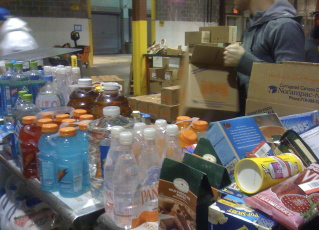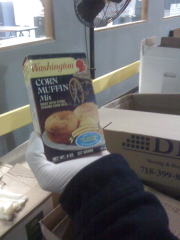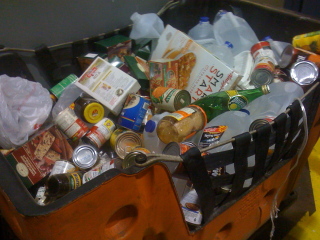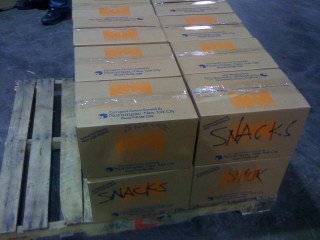Entries in trash (6)
More on recycling
I thought you might find this email exchange amusing...
-----Original Message-----
From: megan metcalf
Sent: Monday, February 25, 2008 2:07 PM
To: Building Management
Subject: Garbage/Recycling: E. 117th
Hi, Manager -
I'm wondering if there's a problem with the garbage at E. 117th? It looks like it hasn't been taken out in weeks: there is a pile to the side of the building that is several bags high and several bags deep. Not only is it disturbing, it makes the stairwell smell and I'm sure it's not helping with the rats and roaches. I hope this will be taken care of right away - I thought the garbage is picked up Monday; I hope we won't have to wait until Thursday.
Also, I thought I'd paste what I found on the DSNY website about recycling here:
"Buildings with ten or more apartments that receive four or more Notices of Violation within a six-month period will be fined $500 for each bag that violates recycling regulations, up to a maximum of 20 bags within a 24-hour period. This translates to a maximum fine of $10,000 per day."
I know New York's recycling rules have been confusing in recent years - I'm sure you're working on getting a functional recycling system together for our building as soon as possible.
Thank you!!
Megan Metcalf
Manager <Manager@dawnaydayusa.com> wrote:
Let me also try to explain how the recycling system works. In order for a system to work everyone has to participate in the system. As you probably notice there may not be any signs posted. That's because each time they are someone tears them down. Also even if the signs remain tenants are not cooperating with recycling anyway. Recycling doesn't just start when you throw the garbage out it starts in your apartment when you separate your garbage before you bring it downstairs.
Now whether or not signs are posted or actual cans are displayed it still does not prevent anyone from bringing down their plastic and bottles in the light blue clear bags. Nor does it stop tenants from tying up old magazines or books before they throw them out. Tenants have to also do their share as well as management.
I do believe that we are presently awaiting the appropriate cans for the correct disposal of everything. Now once they have arrived and everything is set up let's see the tenant participation.
Date: Tue, 26 Feb 2008 07:09:57 -0800 (PST)
From: "megan metcalf"
Subject: RE: Garbage/Recycling: E. 117th
To: "Manager" <Manager@dawnaydayusa.com>
No problem! I've been separating my recycling and taking it on the subway to work, where they recycle. It sometimes gets heavy, though, and they are not so happy with this arrangement. I don't have enough on my own to fill up a clear or blue bag.
I'm so glad to hear about the new cans - I'm sure you're also planning on making the garbage area to the side of the building cleaner and safer, which is probably why people don't go down there. It isn't well lit, there are bugs and rats around, and people not from the building sometimes hang out down there. I'm sure you're aware that my upstairs neighbor was held up at gunpoint in the lobby two weeks ago.
Thanks again for all of your help!
Megan Metcalf
---
Nope, I haven't heard anything since...and, nope, no recycling bins have shown up either. The trash was thankfully thrown away the same day I sent the email - not sure what was going on with that.
New York: easy to love, easy to hate - still here after 10 years!
Food rescue
Last weekend -- perhaps to offset the insane amount of food waste we generate at breakfast and lunch -- my office organized a volunteer opportunity with the Food Bank for New York City. Basically what the Food Bank does is take gigantic donations of food and re-distributes it to hunger programs in the five boroughs. They operate out of an industrial warehouse at the Hunt's Point market in the Bronx. I was super-excited because individuals can't volunteer on their own - they get referred to a partner soup kitchen, homeless shelter, school, etc. While these programs are vital, the Food Bank interests me in particular because of its emphasis on efficiency of resources and reduction of waste.
My coworkers and I were tasked with re-packaging food that had been donated through some of its smaller sources: can drives at schools and workplaces and, surprisingly, Target. If a box of cereal gets run over by a shopping cart or a curious kid damages the packaging of something, the product gets pulled from the shelf; most of the time, these perfectly useful and edible things go into the trash. This thoughtful Target (I don't know which one) dumps them all in boxes and sends them to the Food Bank. (They probably get a tax write-off, too.)
 We were sorting the items by category: fruits, vegetables, household products, personal care, beverages, snacks, etc., and creating boxes of a particular weight, determined by what was inside it. The Food Bank gave us detailed handouts about dented cans and expiration dates: some of the items had to be discarded after their expiration dates, others they have guidelines written by a nutritionist on how long past the date is acceptable to pass the donations along. The items that didn't pass our tests had to go in a big orange trash bin.
We were sorting the items by category: fruits, vegetables, household products, personal care, beverages, snacks, etc., and creating boxes of a particular weight, determined by what was inside it. The Food Bank gave us detailed handouts about dented cans and expiration dates: some of the items had to be discarded after their expiration dates, others they have guidelines written by a nutritionist on how long past the date is acceptable to pass the donations along. The items that didn't pass our tests had to go in a big orange trash bin.
The whole thing was incredibly eye-opening, for a number of reasons. I was astonished at how many things were donated that were way past their expiration dates - this box of muffin mix looks like an antique!  It's great that people open their cabinets during food drives, but I think they forget that actual people are supposed to end up with this stuff. I was also heartbroken every time something went into the trash: I would estimate that 10% of the stuff we sorted ended up in the bin. Maybe 1% of that amount I wouldn't have eaten, faced with the same dilemma at home. Now, I know that I've done some stuff this year that people would label gross by conventional standards - using hankies, not flushing every single time, collecting my food scraps in the fridge for compost. But this stuff was only marginally gross: boxes of things slightly past their expiration, stale cookies, juice with the label ripped off. It killed me to see it tossed - yes, that's water in the bin below (I think the bottle was too misshapen to pass along) - and I know that the Food Bank can't compromise its reputation for this lowly 10%. I asked one of the regular employees if any local homeless people had figured out that the Food Bank bins were full of food. He said he knew some people had been in them before, but they were kind of difficult to get to and it didn't happen very often. The market is geographically isolated, surrounded by gates, high fences, and barbed wire - I doubt too many scavengers make it in.
It's great that people open their cabinets during food drives, but I think they forget that actual people are supposed to end up with this stuff. I was also heartbroken every time something went into the trash: I would estimate that 10% of the stuff we sorted ended up in the bin. Maybe 1% of that amount I wouldn't have eaten, faced with the same dilemma at home. Now, I know that I've done some stuff this year that people would label gross by conventional standards - using hankies, not flushing every single time, collecting my food scraps in the fridge for compost. But this stuff was only marginally gross: boxes of things slightly past their expiration, stale cookies, juice with the label ripped off. It killed me to see it tossed - yes, that's water in the bin below (I think the bottle was too misshapen to pass along) - and I know that the Food Bank can't compromise its reputation for this lowly 10%. I asked one of the regular employees if any local homeless people had figured out that the Food Bank bins were full of food. He said he knew some people had been in them before, but they were kind of difficult to get to and it didn't happen very often. The market is geographically isolated, surrounded by gates, high fences, and barbed wire - I doubt too many scavengers make it in.
 The thing that really got me worked up, though, was what was passing for "food" for needy New Yorkers. For every box of Cheerios we put in the 'cereals' pile, we put at least 3 or 4 boxes of Frosted Flakes, Lucky Charms, or some other sweetened cardboard. Target was happy to pass along cases and cases of green- and red-wrapped chocolates for the holidays, once they had gotten all their mileage out of the half-price sale. They passed along hundreds of pounds of boxes of holiday cookies and cake mix, and even gummy worms and candy vampire teeth from Halloween. It makes me sad that this stuff is marketed and accepted as "food" in America; when I think about it as the only thing available to feed people who actually need nourishment, I start to feel a little sick. By my estimates, we boxed nine or ten 30-pound boxes of vegetables (canned), maybe seven or eight of fruit, and ten or fifteen 25-pound boxes of 'protein' (tuna fish and the like). On the other hand, we packed at least two pallets of beverages (stuff like no-calorie flavored soda) and eight full pallets of 'snacks' -- that's 512 ten-pound boxes of sugary, salty crap!
The thing that really got me worked up, though, was what was passing for "food" for needy New Yorkers. For every box of Cheerios we put in the 'cereals' pile, we put at least 3 or 4 boxes of Frosted Flakes, Lucky Charms, or some other sweetened cardboard. Target was happy to pass along cases and cases of green- and red-wrapped chocolates for the holidays, once they had gotten all their mileage out of the half-price sale. They passed along hundreds of pounds of boxes of holiday cookies and cake mix, and even gummy worms and candy vampire teeth from Halloween. It makes me sad that this stuff is marketed and accepted as "food" in America; when I think about it as the only thing available to feed people who actually need nourishment, I start to feel a little sick. By my estimates, we boxed nine or ten 30-pound boxes of vegetables (canned), maybe seven or eight of fruit, and ten or fifteen 25-pound boxes of 'protein' (tuna fish and the like). On the other hand, we packed at least two pallets of beverages (stuff like no-calorie flavored soda) and eight full pallets of 'snacks' -- that's 512 ten-pound boxes of sugary, salty crap!
 With a sick feeling in my stomach, I asked one of the workers if this was all that was available to the hunger programs. He assured me that these boxes are extras that get added to an order: the majority of their donations come in huge quantities straight from suppliers - things like rice, canned vegetables, cases of cereal, etc. He took me into their bigger warehouse and showed me how everything gets inventoried so their constituent programs can see what's available in real time. They add the boxes of stuff we packed up to the order, based on the size of the order.
With a sick feeling in my stomach, I asked one of the workers if this was all that was available to the hunger programs. He assured me that these boxes are extras that get added to an order: the majority of their donations come in huge quantities straight from suppliers - things like rice, canned vegetables, cases of cereal, etc. He took me into their bigger warehouse and showed me how everything gets inventoried so their constituent programs can see what's available in real time. They add the boxes of stuff we packed up to the order, based on the size of the order.
Which leads me to my final point. I'm sure that the Food Bank needs our hands and eyes for sorting. But what they really need is our money and our awareness. They repeated several times the statistic that 1.3 million New Yorkers rely on emergency food programs - I had no idea that such a large percentage of the city needs this type of assistance, and, with food and fuel prices going up, I'm sure the problem continues to grow. This day was no miracle, but I hope a few more people understand what food means in the city and around the country. Perhaps by this blog maybe even a couple more. Jonathan Bloom, author of Wasted Food, is also doing a great job investigating the problem - I can't wait for his book to come out!
Clandestine recycling
My building doesn’t recycle. According to the NYC Department of Sanitation’s (DSNY’s) extensive and exhausting website, that means the building management could be receiving fines of up to $10,000 per day.* Somehow I doubt that they’re receiving a $10k fine per day – if they were, they would have set up the bins and put out the sign a long time ago. A while back I considered becoming a tenant liaison through the DSNY’s Apartment Building Recycling Initiative Program and then thought better of it, due to my limited Spanish skills and schedule – and the super-sketchiness of the landlord. (You have to get the building management’s permission to help them out.)
Instead, I’ve been tiptoeing around to other neighborhood recycling bins, guiltily tossing in my glass, plastic, metal, and paper. (Sorted and clean!) Before my sister noticed the nearby bins, I had lugged a few huge bagfuls of paper to work. I’m not 100% convinced that they recycle, but I was thinking I had a better chance than with my own building! I’ve managed to reduce my trash quite a bit by paying more attention to the paper; I’ve reduced it further by saving the food scraps in the fridge and taking them down to the farmer’s market once a week. The Lower East Side Ecology Center sets up a collection every Saturday at Union Square – they might even do it on Mon, Wed, Fri as well. I purchased their compost and potting soil for my tomatoes last summer, giving me – in my hyper-urban state – a tiny feeling of living off my land. Unfortunately, Elizabeth Royte from Garbage Land didn’t feel very good about the LESEC; she was concerned about how they process and remove icky chemicals from the rotting food – I’ll have to go down there and see for myself.
Royte’s book also included some interesting thoughts about recycling that I hadn’t really considered up until now. In short, many environmentalists don’t believe in household recycling at all, as it furthers the notion that environmental problems are the responsibility of the consumer, when in fact, the manufacture and packaging of products creates far more waste than any of us throw out. By aggressively promoting recycling, companies and governments don’t have to come up with less wasteful processes or products or meaningful legislation. She says it better than I do:
Individual recycling was not only unhelpful…it was also a shining example of how individual goodwill had been perverted by capitalist goals…By trying to shrink my garbage footprint, I was…abetting a bankrupt system by doing what the government, educators, and environmentalists (who increasingly partnered with corporations) told me to do. Recycling merely made it easier for individuals to keep consuming and to keep discarding. It also gave waste hauling companies who ran recycling programs an opportunity to look as though they cared. (And to make more money.) (Garbage Land, 282).**
*"Buildings with ten or more apartments that receive four or more Notices of Violation within a six-month period will be fined $500 for each bag that violates recycling regulations, up to a maximum of 20 bags within a 24-hour period. This translates to a maximum fine of $10,000 per day."
**To be clear, Royte is referring to her own habits as interpreted by one of these theorists and continues to recycle, as far as I know.
Field Trip!
I paid visits to two awesome Queens organizations in the past week: Build it Green and Materials for the Arts. They're both collecting stuff that people don't need and re-distributing them to people who want random crap.
The first stop was Build it Green, a building-supply store in LIC. They take surplus building materials from contractors and do-it-yourselfers and re-sell them. I'm not exactly sure how much doors or moulding or toilets cost new, so I couldn't tell if they give you a great deal or not. Regardless, they are helping keep construction trash out of the landfill, which accounts for an astonishingly high percentage of what gets thrown away. The haphazard warehouse had lots of paint, doors, cabinets, toilets, and appliances, as well as thrift store-type stuff like furniture and books. It was fun to hunt around for awhile, but didn't yield the paint or hooks I was looking for.
Materials for the Arts is a program run by NYC's Department of Sanitation and the Department of Cultural Affairs. They distribute anything you can imagine to artists and teachers working with qualifying arts organizations/schools. I saw furniture, office supplies, gigantic wheels, hundreds of team patches for hats and clothes, buttons, a huge glass globe - the list goes on and on - while "shopping" in their warehouse. My more experienced friend tells me that their inventory is completely different every time you go. People and companies donate their unwanted stuff to MFTA in exchange for a tax write-off. It seems that nothing is too miscellaneous: a group of helpful sculptor girls from Pratt had carts overflowing with metal rods, paper, paint, and many other things I couldn't identify. I'm not sure how great the ecological impact of this venture is in the end, but I love the idea of artists transforming the city's garbage into magic. I was looking for file cabinets and furniture for my upcoming installation project, but got a little overwhelmed by the sheer possibilities in the place. If anyone's got extra two-drawer file cabinets, please let me know.
As much as I enjoyed my recent adventures, the visits taught me a little about myself - things I wasn't too keen to learn. I'm an impatient shopper: years of Home Depot and my own personal peculiarities made hunting and digging a little frustrating. I love walking into a place, locating exactly what I need amongst a million choices, and walking out in no time. This is really counter to what Fix is about -- exploration, adventure, the unexpected -- and I'm not sure my desire for efficiency is something I'll get over this year, if ever. Is it people like me who are plundering the world's resources in the name of convenience?



Take it Away
I'm not sure why not buying anything new also means getting rid of stuff. I've unloaded lots of crap in the last few months - I guess Fix helps me sort out what I really need. Or maybe I have more time to go through my stuff. Or something. Today I finally dumped a busted computer at the NYC Department of Sanitation's electronics recycling event, which happily coincided with Earth Day. Does anyone know what happens to this stuff once they haul it away?
The photo was taken at 9.30 in the morning - I wonder what it looked like at the end of the day!
NYC Dept. of Sanitation Events Calendar (did you know such a thing existed?)
Paper
I recently finished Rathje and Murphy's Rubbish!, a book I'll come back to when I investigate trash in more detail. Though a little out-of-date, it left a couple of lasting impressions: for one thing, I learned that over forty percent of the waste in landfills is paper -- and it doesn't biodegrade like we all think it does. Furthermore, at the time of the book's writing (10 years ago), there wasn't a large enough market for recycled paper products to make it an eco-efficient enterprise. I already avoid some of the pitfalls on paper: I read the newspaper online, I use the backs of printed out directions and maps and whatnot for the nine million lists I make a week. But I'd like to reduce more. Five minutes on the phone today supposedly means that I won't get catalogs from J. Crew or Anthropologie or other "similar companies" anymore (we'll see...). When I'm buying things again, I'll aim to purchase products with 30% or more post-consumer recycled content. Other ideas?
New efforts include: a vow to restrain myself around postcards for art and shows -- I'm addicted to them but they usually end up in the trash. I also signed up for paperless statements through Citibank: they promise to plant a tree through the National Arbor Day Foundation in exchange for my efforts. I hope they don't send me a million postcards thanking me for the tree.
Finally, last week I created a pile of already-printed paper that instead of recycling right away I'll use for the voluminous internal reports I have to print out almost daily. I will confess, though, that this last measure feels a little silly. I know, I know, "every little bit helps!" and I'll keep it up this year -- but this and other small, squirrely efforts make me feel less empowered, not more. (Maybe it's because it's at work, where I don't have much power?) Rathje and Murphy assert that rather than viewing our garbage problem as a crisis, "a more rational policy would consist of muddling along, making improvements at the margin all the time, applying the fruits of advancing technology and of new knowledge about human behavior..." I've got the muddling down, and I'm learning that some humans like myself need dramatic results in order to feel like they're making a difference.

